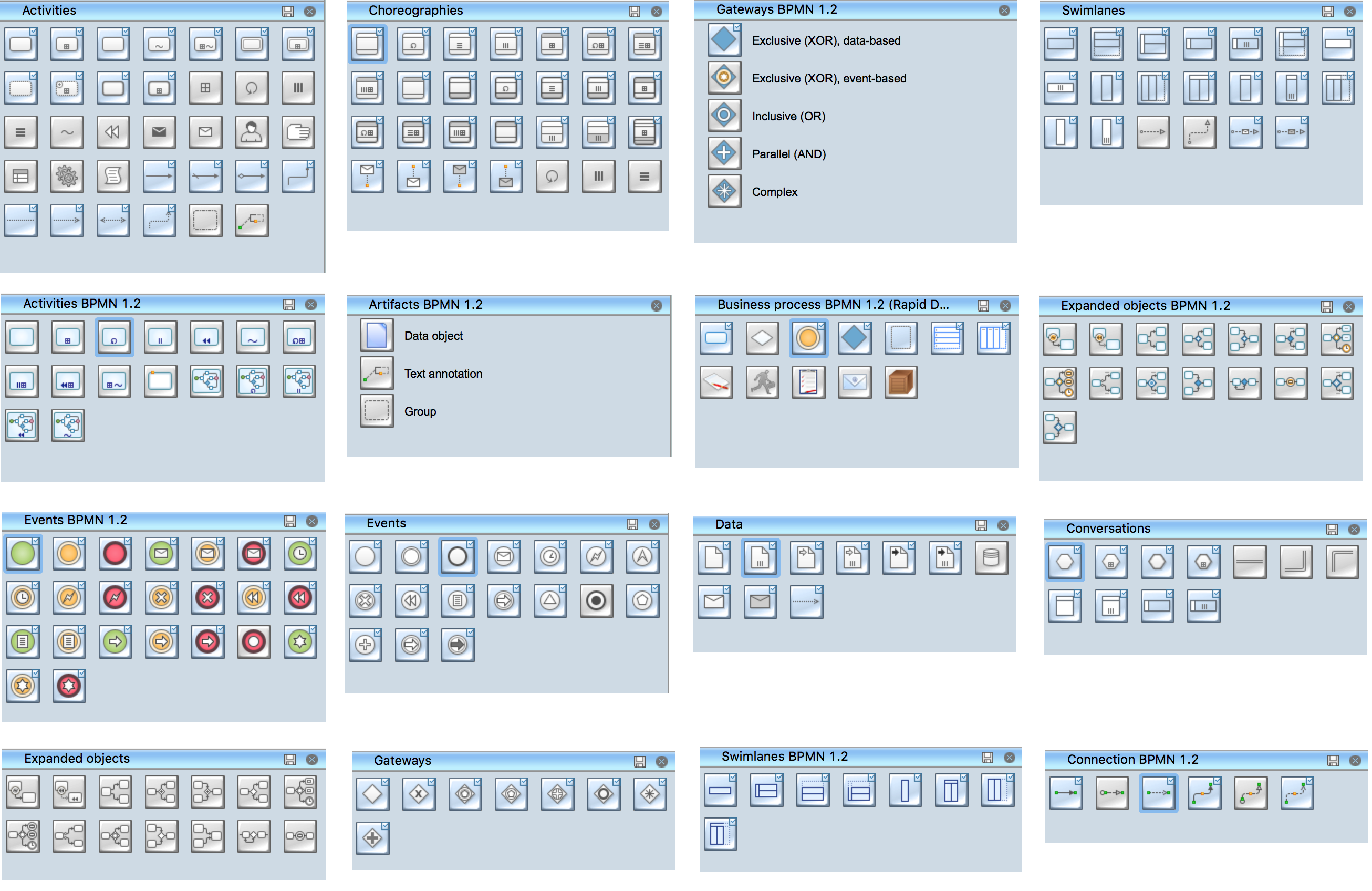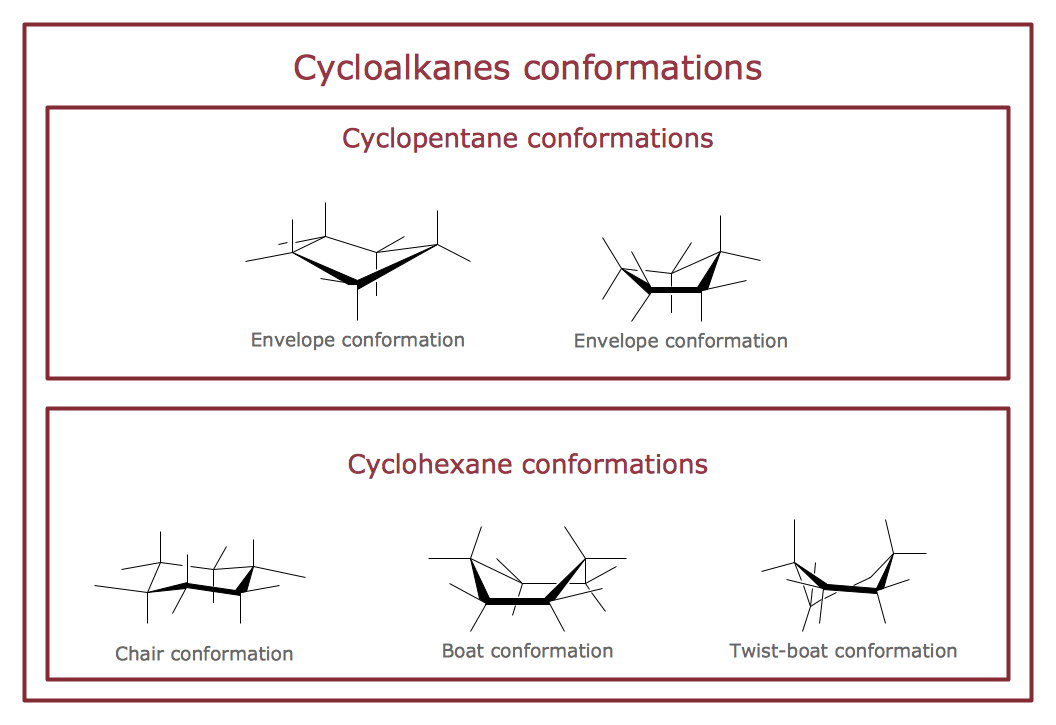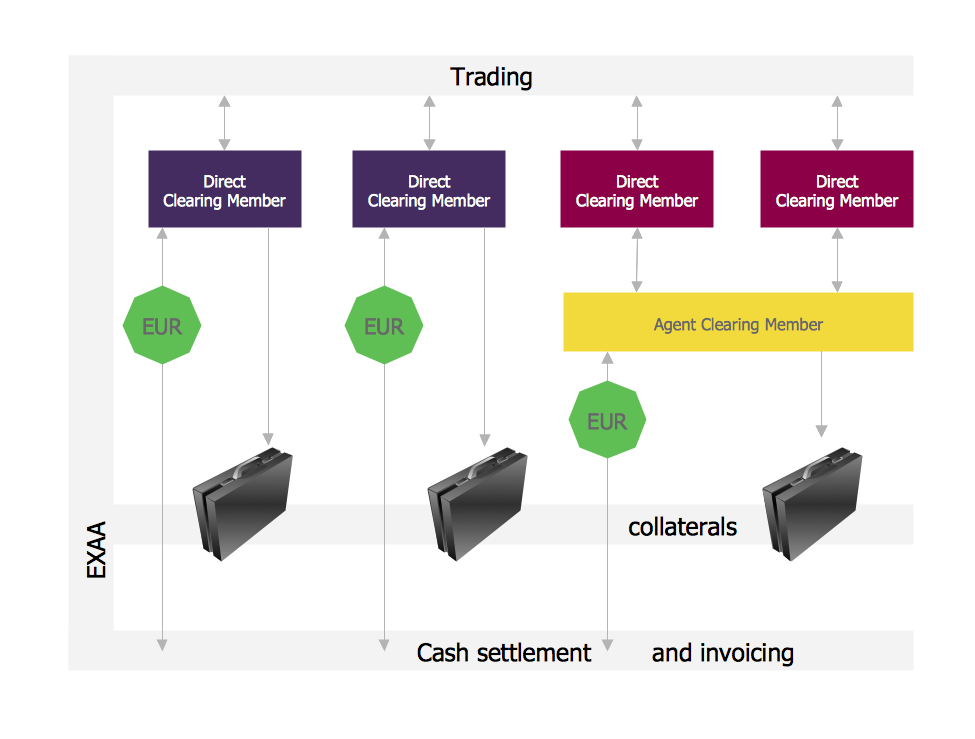Local area network (LAN). Computer and Network Examples
Local Area Network (LAN) is a network which consists of computers and peripheral devices connected each other and to the local domain server, and covers a little territory or small number of buildings, such as home, school, laboratory, office, etc. LAN serves for few hundreds of users. It includes many cables and wires, and demands to design previously a Network diagram. All local area network devices can use the shared printers and disk storage. ConceptDraw DIAGRAM is a perfect network diagramming software with examples of LAN Diagrams, templates and predesigned vector objects. ConceptDraw DIAGRAM is the ideal choice for network engineers and network designers who need to draw fast and easy Local Area Network Diagrams, for IT specialists, developers and other IT professionals which need to visualize the communication schemes of LAN and visually document the LAN's physical structure and arrangement in houses, offices and other buildings. Ready-to-use vector objects from Computer Network Diagrams solution will help you design LAN diagrams in minutes.
The vector stencils library "Chemical elements" contains 118 icon symbols of chemical elements.
Use these shapes for drawing atoms, structural formulas of inorganic and organic molecules and ions, and schemes of chemical reaction mechanisms in the ConceptDraw PRO diagramming and vector drawing software extended with the Chemistry solution from the Science and Education area of ConceptDraw Solution Park.
www.conceptdraw.com/ solution-park/ science-education-chemistry
Use these shapes for drawing atoms, structural formulas of inorganic and organic molecules and ions, and schemes of chemical reaction mechanisms in the ConceptDraw PRO diagramming and vector drawing software extended with the Chemistry solution from the Science and Education area of ConceptDraw Solution Park.
www.conceptdraw.com/ solution-park/ science-education-chemistry
The vector stencils library "Chemical elements" contains 118 icon symbols of chemical elements for drawing atoms, structural formulas and ball-and-stick models of inorganic and organic molecules and ions, and schemes of chemical reaction mechanisms.
"In chemistry, the ball-and-stick model is a molecular model of a chemical substance which is to display both the three-dimensional position of the atoms and the bonds between them. The atoms are typically represented by spheres, connected by rods which represent the bonds. Double and triple bonds are usually represented by two or three curved rods, respectively. In a good model, the angles between the rods should be the same as the angles between the bonds, and the distances between the centers of the spheres should be proportional to the distances between the corresponding atomic nuclei. The chemical element of each atom is often indicated by the sphere's color." [Ball-and-stick model. Wikipedia]
The chemical symbols example "Design elements - Chemical elements" was created using the ConceptDraw PRO software extended with the Chemistry solution from the Science and Education area of ConceptDraw Solution Park.
"In chemistry, the ball-and-stick model is a molecular model of a chemical substance which is to display both the three-dimensional position of the atoms and the bonds between them. The atoms are typically represented by spheres, connected by rods which represent the bonds. Double and triple bonds are usually represented by two or three curved rods, respectively. In a good model, the angles between the rods should be the same as the angles between the bonds, and the distances between the centers of the spheres should be proportional to the distances between the corresponding atomic nuclei. The chemical element of each atom is often indicated by the sphere's color." [Ball-and-stick model. Wikipedia]
The chemical symbols example "Design elements - Chemical elements" was created using the ConceptDraw PRO software extended with the Chemistry solution from the Science and Education area of ConceptDraw Solution Park.
The vector stencils library "Periodic table of chemical elements" contains 119 icon symbols of chemical elements for drawing Mendeleev's periodic table, chemical diagrams, infographics and illustrations.
"A chemical element is a pure chemical substance consisting of a single type of atom distinguished by its atomic number, which is the number of protons in its atomic nucleus. Elements are divided into metals, metalloids, and non-metals. Familiar examples of elements are carbon, nitrogen, oxygen (non-metals), silicon, arsenic (metalloids), aluminium, iron, copper, gold, mercury, and lead (metals).
The lightest chemical elements, including hydrogen, helium and smaller amounts of lithium, beryllium and boron, are thought to have been produced by various cosmic processes during the Big Bang and cosmic-ray spallation. Production of heavier elements, from carbon to the very heaviest elements, proceeded by stellar nucleosynthesis, and these were made available for later solar system and planetary formation by planetary nebulae and supernovae, which blast these elements into space. The high abundance of oxygen, silicon, and iron on Earth reflects their common production in such stars. While most elements are generally stable, a small amount of natural transformation of one element to another also occurs in the decay of radioactive elements as well as other natural nuclear processes." [Chemical element. Wikipedia]
The chemical symbols example "Design elements - Periodic table of chemical elements" was created using the ConceptDraw PRO software extended with the Chemistry solution from the Science and Education area of ConceptDraw Solution Park.
"A chemical element is a pure chemical substance consisting of a single type of atom distinguished by its atomic number, which is the number of protons in its atomic nucleus. Elements are divided into metals, metalloids, and non-metals. Familiar examples of elements are carbon, nitrogen, oxygen (non-metals), silicon, arsenic (metalloids), aluminium, iron, copper, gold, mercury, and lead (metals).
The lightest chemical elements, including hydrogen, helium and smaller amounts of lithium, beryllium and boron, are thought to have been produced by various cosmic processes during the Big Bang and cosmic-ray spallation. Production of heavier elements, from carbon to the very heaviest elements, proceeded by stellar nucleosynthesis, and these were made available for later solar system and planetary formation by planetary nebulae and supernovae, which blast these elements into space. The high abundance of oxygen, silicon, and iron on Earth reflects their common production in such stars. While most elements are generally stable, a small amount of natural transformation of one element to another also occurs in the decay of radioactive elements as well as other natural nuclear processes." [Chemical element. Wikipedia]
The chemical symbols example "Design elements - Periodic table of chemical elements" was created using the ConceptDraw PRO software extended with the Chemistry solution from the Science and Education area of ConceptDraw Solution Park.
Process Flowchart Symbols
The Process Flowchart or Process Flowchart Diagram (PFD) is a visual representation relations between major parts of the system, the steps in a process, and even connections between various systems. The possibility to easy create professional-looking and attractive Process Flowcharts, Business Process Diagrams and Maps which visualize the steps of complex processes is provided by Business Process Diagram Solution from the Business Processes Area of ConceptDraw Solution Park and 16 libraries with 230 process flowchart symbols from BPMN 1.2 and BPMN 2.0.Chemistry Drawings
ConceptDraw DIAGRAM diagramming and vector drawing software extended with Chemistry solution from the Science and Education area is a powerful chemistry drawing software that is ideal for quick and easy designing of various: chemistry drawings, scientific and educational chemistry illustrations, schemes and diagrams of chemical and biological lab set-ups, images with chemical formulas, molecular structures, chemical reaction schemes, schemes of labware, that can be then successfully used in the field of science and education, on various conferences, and so on.Settlement Process Flowchart. Flowchart Examples
Create your own flow charts of settlement processes using the ConceptDraw DIAGRAM diagramming and vector drawing software extended with the Cross-Functional Flowcharts solution from the Business Processes area of ConceptDraw Solution Park. Download easy flowchart software to create settlement process flowcharts show steps of monthly settlement with your business quickly and easily.- Magnesium Icon
- TI Symbols
- Selenium Icon
- Health Food | Chemical elements - Vector stencils library | Calcium ...
- Chemical elements - Vector stencils library | Chemical elements ...
- Chemical elements - Vector stencils library | Cafe Floor Plan. Cafe ...
- Chemical elements - Vector stencils library | Mechanical Drawing ...
- Chemical elements - Vector stencils library | Process Flow Diagram ...
- Design elements - Periodic table of chemical elements | Design ...
- F&B | Chemical elements - Vector stencils library | Chemical ...
- Pic Ti Draw Of Computer Network Topology
- Lighting and switch layout | How To use House Electrical Plan ...
- Design elements - Periodic table of chemical elements | Design ...
- Jet fuel mercaptan oxidation treating - PFD | Chemical elements ...
- Design elements - Periodic table of chemical elements | How To ...
- Design elements - Periodic table of chemical elements
- Flowchart of Products. Flowchart Examples | Process Flowchart ...
- SWOT Matrix Template | SWOT and TOWS Matrix Diagrams | SWOT ...
- Radium Symbol
- How to Draw Chemistry Structures | Interior Design Office Layout ...

-chemical-elements---vector-stencils-library.png--diagram-flowchart-example.png)
-chemical-elements---vector-stencils-library.png--diagram-flowchart-example.png)
-chemical-elements---vector-stencils-library.png--diagram-flowchart-example.png)
-chemical-elements---vector-stencils-library.png--diagram-flowchart-example.png)
-chemical-elements---vector-stencils-library.png--diagram-flowchart-example.png)
-chemical-elements---vector-stencils-library.png--diagram-flowchart-example.png)
-chemical-elements---vector-stencils-library.png--diagram-flowchart-example.png)
-chemical-elements---vector-stencils-library.png--diagram-flowchart-example.png)
-chemical-elements---vector-stencils-library.png--diagram-flowchart-example.png)
-chemical-elements---vector-stencils-library.png--diagram-flowchart-example.png)
-chemical-elements---vector-stencils-library.png--diagram-flowchart-example.png)
-chemical-elements---vector-stencils-library.png--diagram-flowchart-example.png)
-chemical-elements---vector-stencils-library.png--diagram-flowchart-example.png)
-chemical-elements---vector-stencils-library.png--diagram-flowchart-example.png)
-chemical-elements---vector-stencils-library.png--diagram-flowchart-example.png)
-chemical-elements---vector-stencils-library.png--diagram-flowchart-example.png)
-chemical-elements---vector-stencils-library.png--diagram-flowchart-example.png)
-chemical-elements---vector-stencils-library.png--diagram-flowchart-example.png)
-chemical-elements---vector-stencils-library.png--diagram-flowchart-example.png)
-chemical-elements---vector-stencils-library.png--diagram-flowchart-example.png)
-chemical-elements---vector-stencils-library.png--diagram-flowchart-example.png)
-chemical-elements---vector-stencils-library.png--diagram-flowchart-example.png)
-chemical-elements---vector-stencils-library.png--diagram-flowchart-example.png)
-chemical-elements---vector-stencils-library.png--diagram-flowchart-example.png)
-chemical-elements---vector-stencils-library.png--diagram-flowchart-example.png)
-chemical-elements---vector-stencils-library.png--diagram-flowchart-example.png)
-chemical-elements---vector-stencils-library.png--diagram-flowchart-example.png)
-chemical-elements---vector-stencils-library.png--diagram-flowchart-example.png)
-chemical-elements---vector-stencils-library.png--diagram-flowchart-example.png)
-chemical-elements---vector-stencils-library.png--diagram-flowchart-example.png)
-chemical-elements---vector-stencils-library.png--diagram-flowchart-example.png)
-chemical-elements---vector-stencils-library.png--diagram-flowchart-example.png)
-chemical-elements---vector-stencils-library.png--diagram-flowchart-example.png)
-chemical-elements---vector-stencils-library.png--diagram-flowchart-example.png)
-chemical-elements---vector-stencils-library.png--diagram-flowchart-example.png)
-chemical-elements---vector-stencils-library.png--diagram-flowchart-example.png)
-chemical-elements---vector-stencils-library.png--diagram-flowchart-example.png)
-chemical-elements---vector-stencils-library.png--diagram-flowchart-example.png)
-chemical-elements---vector-stencils-library.png--diagram-flowchart-example.png)
-chemical-elements---vector-stencils-library.png--diagram-flowchart-example.png)
-chemical-elements---vector-stencils-library.png--diagram-flowchart-example.png)
-chemical-elements---vector-stencils-library.png--diagram-flowchart-example.png)
-chemical-elements---vector-stencils-library.png--diagram-flowchart-example.png)
-chemical-elements---vector-stencils-library.png--diagram-flowchart-example.png)
-chemical-elements---vector-stencils-library.png--diagram-flowchart-example.png)
-chemical-elements---vector-stencils-library.png--diagram-flowchart-example.png)
-chemical-elements---vector-stencils-library.png--diagram-flowchart-example.png)
-chemical-elements---vector-stencils-library.png--diagram-flowchart-example.png)
-chemical-elements---vector-stencils-library.png--diagram-flowchart-example.png)
-chemical-elements---vector-stencils-library.png--diagram-flowchart-example.png)
-chemical-elements---vector-stencils-library.png--diagram-flowchart-example.png)
-chemical-elements---vector-stencils-library.png--diagram-flowchart-example.png)
-chemical-elements---vector-stencils-library.png--diagram-flowchart-example.png)
-chemical-elements---vector-stencils-library.png--diagram-flowchart-example.png)
-chemical-elements---vector-stencils-library.png--diagram-flowchart-example.png)
-chemical-elements---vector-stencils-library.png--diagram-flowchart-example.png)
-chemical-elements---vector-stencils-library.png--diagram-flowchart-example.png)
-chemical-elements---vector-stencils-library.png--diagram-flowchart-example.png)
-chemical-elements---vector-stencils-library.png--diagram-flowchart-example.png)
-chemical-elements---vector-stencils-library.png--diagram-flowchart-example.png)
-chemical-elements---vector-stencils-library.png--diagram-flowchart-example.png)
-chemical-elements---vector-stencils-library.png--diagram-flowchart-example.png)
-chemical-elements---vector-stencils-library.png--diagram-flowchart-example.png)
-chemical-elements---vector-stencils-library.png--diagram-flowchart-example.png)
-chemical-elements---vector-stencils-library.png--diagram-flowchart-example.png)
-chemical-elements---vector-stencils-library.png--diagram-flowchart-example.png)
-chemical-elements---vector-stencils-library.png--diagram-flowchart-example.png)
-chemical-elements---vector-stencils-library.png--diagram-flowchart-example.png)
-chemical-elements---vector-stencils-library.png--diagram-flowchart-example.png)
-chemical-elements---vector-stencils-library.png--diagram-flowchart-example.png)
-chemical-elements---vector-stencils-library.png--diagram-flowchart-example.png)
-chemical-elements---vector-stencils-library.png--diagram-flowchart-example.png)
-chemical-elements---vector-stencils-library.png--diagram-flowchart-example.png)
-chemical-elements---vector-stencils-library.png--diagram-flowchart-example.png)
-chemical-elements---vector-stencils-library.png--diagram-flowchart-example.png)
-chemical-elements---vector-stencils-library.png--diagram-flowchart-example.png)
-chemical-elements---vector-stencils-library.png--diagram-flowchart-example.png)
-chemical-elements---vector-stencils-library.png--diagram-flowchart-example.png)
-chemical-elements---vector-stencils-library.png--diagram-flowchart-example.png)
-chemical-elements---vector-stencils-library.png--diagram-flowchart-example.png)
-chemical-elements---vector-stencils-library.png--diagram-flowchart-example.png)
-chemical-elements---vector-stencils-library.png--diagram-flowchart-example.png)
-chemical-elements---vector-stencils-library.png--diagram-flowchart-example.png)
-chemical-elements---vector-stencils-library.png--diagram-flowchart-example.png)
-chemical-elements---vector-stencils-library.png--diagram-flowchart-example.png)
-chemical-elements---vector-stencils-library.png--diagram-flowchart-example.png)
-chemical-elements---vector-stencils-library.png--diagram-flowchart-example.png)
-chemical-elements---vector-stencils-library.png--diagram-flowchart-example.png)
-chemical-elements---vector-stencils-library.png--diagram-flowchart-example.png)
-chemical-elements---vector-stencils-library.png--diagram-flowchart-example.png)
-chemical-elements---vector-stencils-library.png--diagram-flowchart-example.png)
-chemical-elements---vector-stencils-library.png--diagram-flowchart-example.png)
-chemical-elements---vector-stencils-library.png--diagram-flowchart-example.png)
-chemical-elements---vector-stencils-library.png--diagram-flowchart-example.png)
-chemical-elements---vector-stencils-library.png--diagram-flowchart-example.png)
-chemical-elements---vector-stencils-library.png--diagram-flowchart-example.png)
-chemical-elements---vector-stencils-library.png--diagram-flowchart-example.png)
-chemical-elements---vector-stencils-library.png--diagram-flowchart-example.png)
-chemical-elements---vector-stencils-library.png--diagram-flowchart-example.png)
-chemical-elements---vector-stencils-library.png--diagram-flowchart-example.png)
-chemical-elements---vector-stencils-library.png--diagram-flowchart-example.png)
-chemical-elements---vector-stencils-library.png--diagram-flowchart-example.png)
-chemical-elements---vector-stencils-library.png--diagram-flowchart-example.png)
-chemical-elements---vector-stencils-library.png--diagram-flowchart-example.png)
-chemical-elements---vector-stencils-library.png--diagram-flowchart-example.png)
-chemical-elements---vector-stencils-library.png--diagram-flowchart-example.png)
-chemical-elements---vector-stencils-library.png--diagram-flowchart-example.png)
-chemical-elements---vector-stencils-library.png--diagram-flowchart-example.png)
-chemical-elements---vector-stencils-library.png--diagram-flowchart-example.png)
-chemical-elements---vector-stencils-library.png--diagram-flowchart-example.png)
-chemical-elements---vector-stencils-library.png--diagram-flowchart-example.png)
-chemical-elements---vector-stencils-library.png--diagram-flowchart-example.png)
-chemical-elements---vector-stencils-library.png--diagram-flowchart-example.png)
-chemical-elements---vector-stencils-library.png--diagram-flowchart-example.png)
-chemical-elements---vector-stencils-library.png--diagram-flowchart-example.png)
-chemical-elements---vector-stencils-library.png--diagram-flowchart-example.png)
-chemical-elements---vector-stencils-library.png--diagram-flowchart-example.png)


